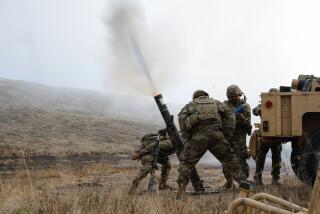Pentagon Lifts Freeze on New Construction : Military: S.D. County to get additional housing for military personnel and upgrading of piers at North Island.
The Defense Department lifted a freeze on military construction Thursday, clearing the way for about $57 million in Navy and Marine Corps projects in San Diego County, including $10.9 million for renovations to North Island Naval Air Station piers to allow nuclear-powered aircraft carriers to be based there.
The benefits from canceling the moratorium will extend beyond San Diego’s military community, easing the housing pinch as well as pumping millions of dollars into the construction industry, local officials said.
The unprecedented moratorium, in place since Jan. 24, 1990, caused much military construction to be halted in San Diego and across the nation. It meant bases, such as Camp Pendleton, were cramped by insufficient housing; others, such as Miramar Naval Air Station, lacked adequate classrooms to train pilots.
And the freeze, the first of its kind in two decades, also brought to a standstill what the Navy considers a highly regarded project, fixing the piers at North Island Naval Air Station so a nuclear-powered aircraft carrier can be docked there and hook up to base utilities.
“This is great for us,” said Capt. Bill Scarborough, executive officer of Southwest Engineering Division, which coordinates Navy and Marine Corps construction for the area. “January, 1990, was a long time ago. Obviously, we have a customer for every one of those projects that was put on hold.”
When the building moratorium was first announced, 20 local projects were grounded, halting $70 million in work. But local Navy officials requested--and received--a waiver that enabled them to proceed with 11 projects, including a $5-million, 600-car parking garage for the Naval Hospital in Balboa Park, and child-care facilities at the Marine Corps Recruit Depot and in Murphy Canyon.
Other projects, such as the renovation of North Island’s piers, didn’t get out of the starting gate. Navy officials, however, have now selected the lowest bidder, a San Marcos company, for the $10.8-million, two-year project.
If all goes according to plan, construction will begin in June or July, said John Phillips, deputy acquisitions project management officer at Southwest Engineering Division.
San Diego, home to 15 nuclear-powered attack submarines, has never been the home port for nuclear-powered aircraft carriers, which are considered the wave of the future since the Navy is no longer building conventionally powered carriers, such as the Independence and Ranger.
Construction on the George Washington, the Navy’s next nuclear carrier, will be finished in 1993. The ship has yet to be assigned a home port, though many bases are expected to woo the Navy for the vessel because it represents about a $100-million infusion annually into the local economy.
Basing a nuclear carrier in San Diego is a “high priority,” Vice Adm. Edwin R. Kohn Jr., commander of the Pacific Fleet’s Naval Air Force, said in an earlier interview with The Times.
Now, when a nuclear carrier visits San Diego, it must supply its own power while in port. The renovated pier at North Island will enable one nuclear carrier to draw power from the shore. To do this, the existing berth will be changed so it can provide 4,160 volts of electricity, instead of 480 volts.
Opponents to nuclear power expressed dismay that the moratorium was lifted, allowing the work on the pier to begin.
“It just subjects us to more possibilities of nuclear accidents,” said Carol Jahnkow, director of the Peace Resource Center. “It just ups the ante in terms of the possibility of something going wrong.”
Others in the business community and construction industry welcomed the end of the moratorium.
“This comes at a good time when the economy has been depressed--it will be a stimulus and help us recover,” said Max Schetter, director of the San Diego Chamber of Commerce’s economic research bureau.
Schetter predicted that the benefits will be felt in the construction industry as well as the housing market. Because much of the construction includes housing for military personnel, the housing pinch in San Diego will be eased, he said. “It’s going to be a sluggish year for us, and this is going to help us recover.”
With the freeze removed, Navy officials hope to start several projects, including:
* $25 million for a housing project at Camp Pendleton that will create 1,220 residences.
* $1 million in safety improvements to the physics laboratory at the Naval Ocean Systems Center on Point Loma.
* $5 million to $10 million to build 300 housing units at the Anti-Submarine Warfare Training Center on San Diego Bay.
* $5 million for new classrooms, information storage vaults and training areas at Miramar Naval Air Station.
More to Read
Sign up for Essential California
The most important California stories and recommendations in your inbox every morning.
You may occasionally receive promotional content from the Los Angeles Times.










